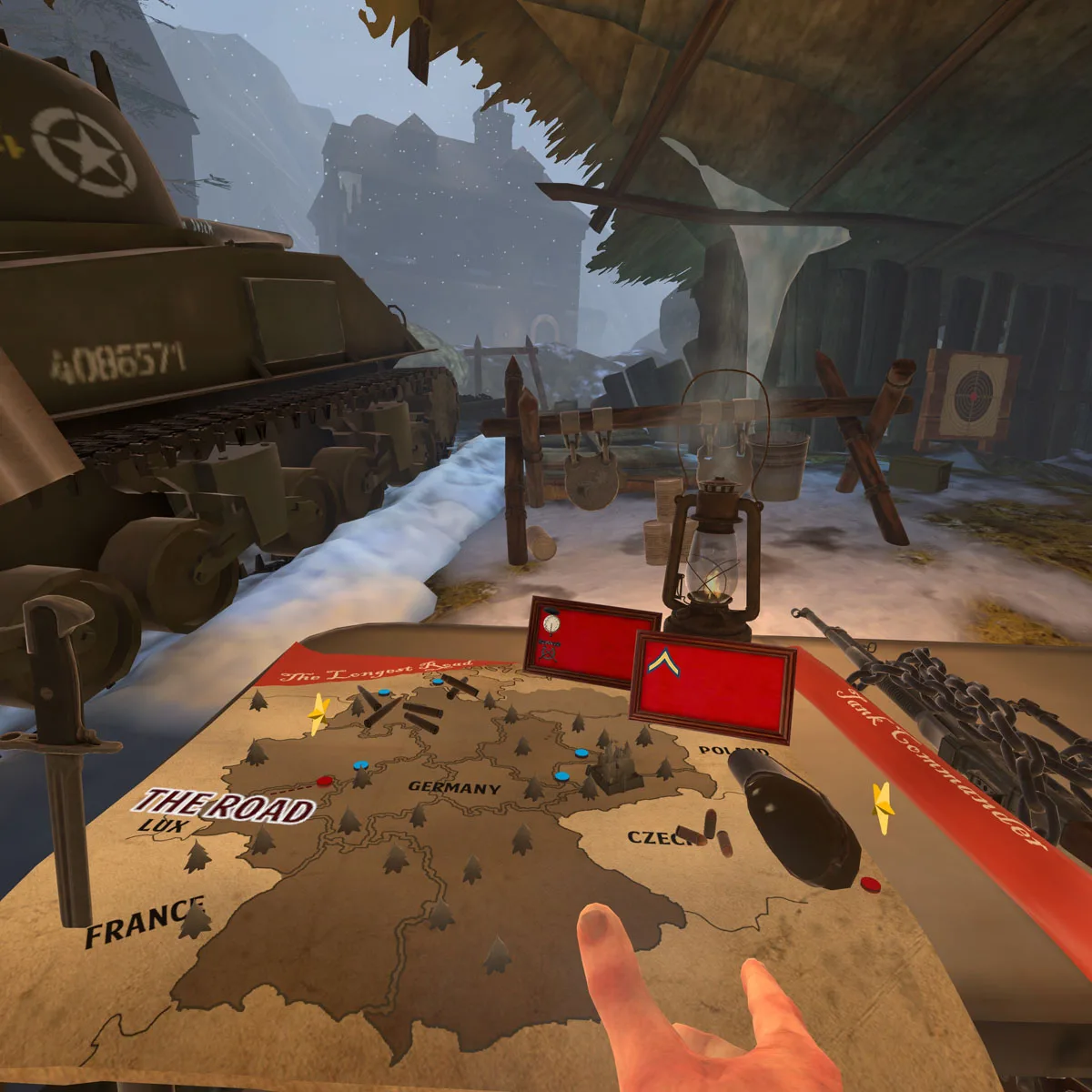Winter Fury: The Longest Road VR Tank Game Wave Shooter Review & Performance Guide
BTR received a reviewer’s key from SpiderMonk Entertainment‘s PR just before the launch of Winter Fury: The Longest Road out of Steam Early Access on December 18. It was difficult transitioning from MechWarrior 5, a mostly strategy-based mech fighting pancake sim with a bad tendency to having an arcade feel, to a tank fighting VR game that deliberately aims for an arcade feeling of intense World War II Nazi-shooting fun.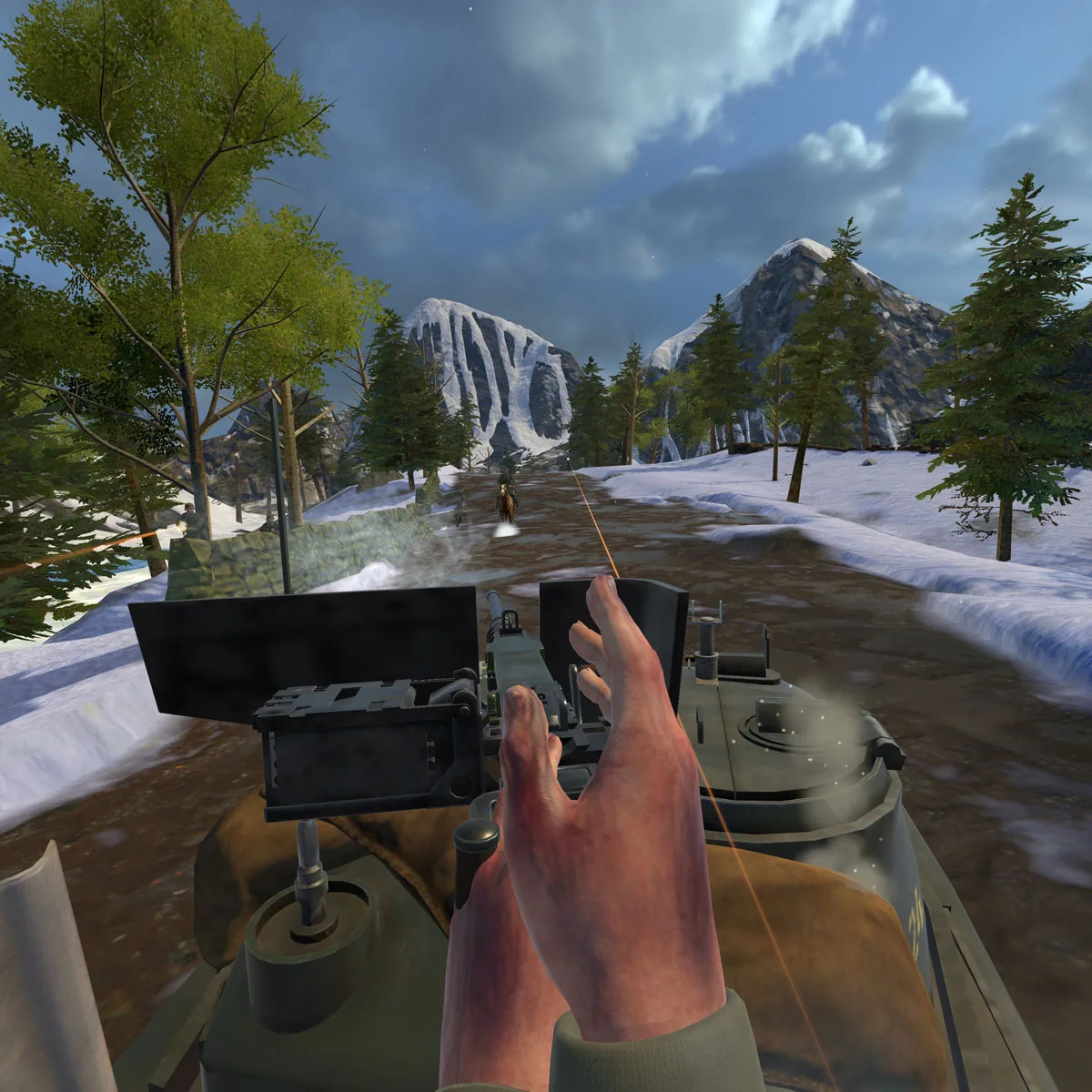
Winter Fury: The Longest Road is available from Steam as a SteamVR game that is playable on multiple HMDs. The benchmarking PC used a RTX 2070S to power a Vive Pro (1440×1600 per eye) which represents the more demanding HMDs including the Valve Index, and with an Oculus Rift CV-1 (1080×1200 per eye) to represent the first generation of HMDs including the original Vive. An i7-8700K overclocked to 4.8GHz on a EVGA Z370 MB using T-FORCE DDR4 3866MHz on Windows 10 with everything up to date completes the test PC and we used FCAT-VR to measure and chart performance.
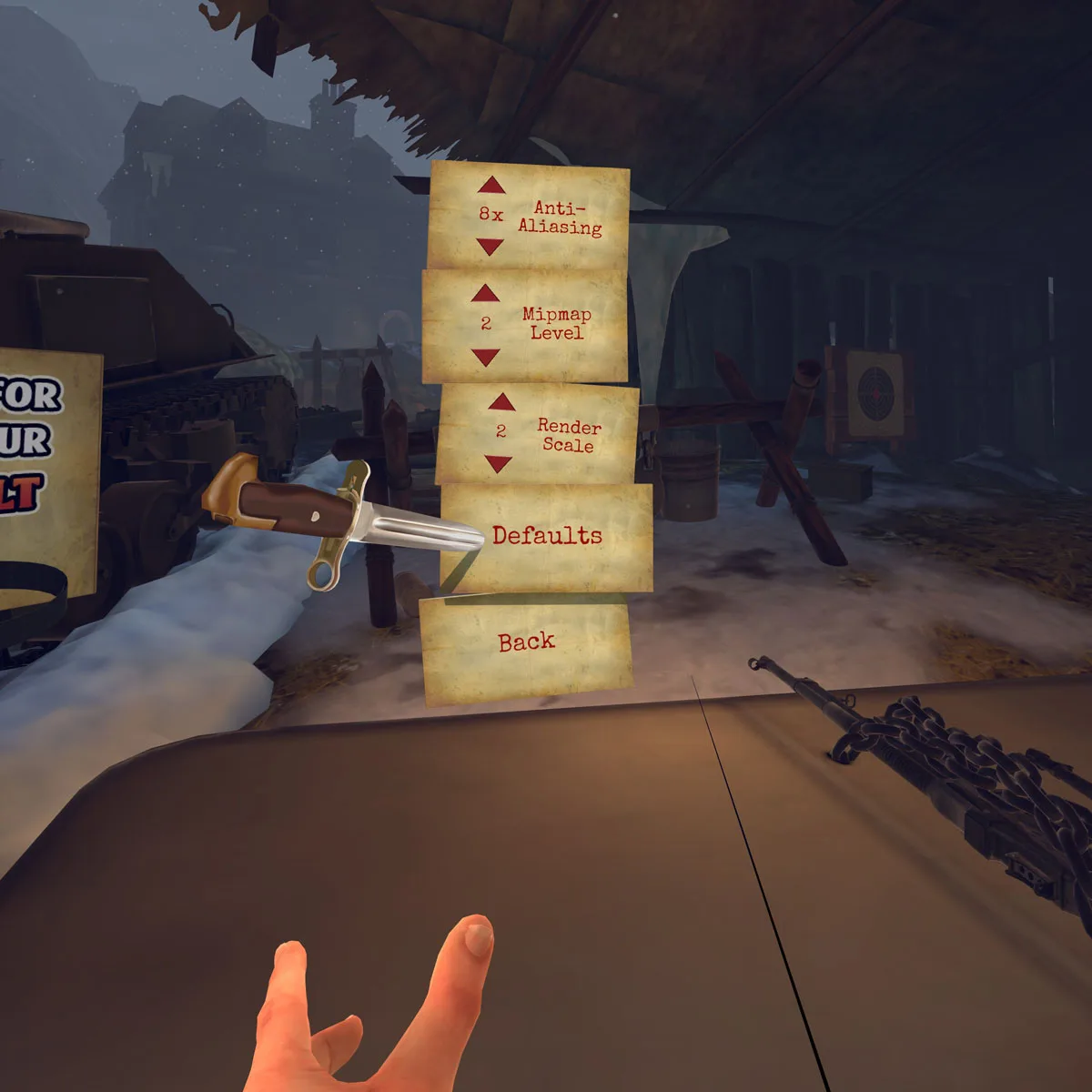 Winter Fury: The Longest Road has average visuals and its minimum requirements include an i7-4790K, 8GB RAM, and a GTX 970 or RX 290. Recommended specs bump the video cards up to a GTX 1060 or a RX 480. Graphics settings are bare bones, and since we have a lot of headroom we bumped the resolution up to 1.7x/4xAA for the Vive Pro and 2.0x/8xAA for the Rift CV-1. This gave us clearer text, cleaned up a lot of jaggies, and reduced the screen door effect for both HMDs with the most impressive visuals still on the Pro. However, we found Oculus Touch controller thumbstick to be easier to use than the Vive Wands thumb controller for aiming the tank turret’s cannon.
Winter Fury: The Longest Road has average visuals and its minimum requirements include an i7-4790K, 8GB RAM, and a GTX 970 or RX 290. Recommended specs bump the video cards up to a GTX 1060 or a RX 480. Graphics settings are bare bones, and since we have a lot of headroom we bumped the resolution up to 1.7x/4xAA for the Vive Pro and 2.0x/8xAA for the Rift CV-1. This gave us clearer text, cleaned up a lot of jaggies, and reduced the screen door effect for both HMDs with the most impressive visuals still on the Pro. However, we found Oculus Touch controller thumbstick to be easier to use than the Vive Wands thumb controller for aiming the tank turret’s cannon.
Campaigns and Gameplay
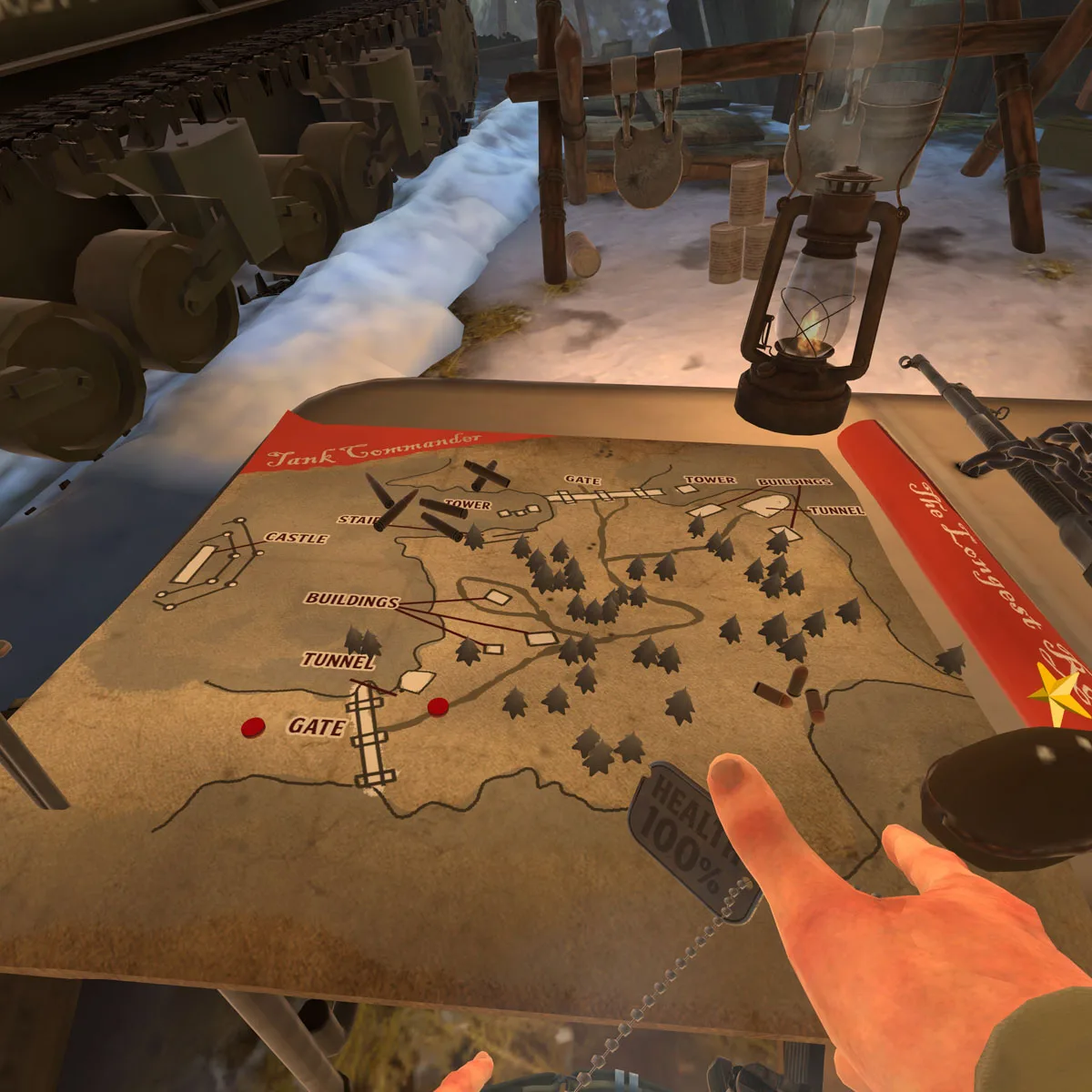 Winter Fury: The Longest Road has two distinct campaigns each with six missions and with varying objectives. After a brief Tank Commander campaign tutorial, you go up against hordes of Axis light and heavy troops in a then experimental M-4 Sherman tank. VR is used with good effect transforming a wave shooter into something almost sim-like, capturing a tank’s claustrophobic interior with a limited view of the battlefield together with controlling movement and precise weapon firing.
Winter Fury: The Longest Road has two distinct campaigns each with six missions and with varying objectives. After a brief Tank Commander campaign tutorial, you go up against hordes of Axis light and heavy troops in a then experimental M-4 Sherman tank. VR is used with good effect transforming a wave shooter into something almost sim-like, capturing a tank’s claustrophobic interior with a limited view of the battlefield together with controlling movement and precise weapon firing.

Players can stay inside and fire a never-ending stream of bullets at light targets while aiming and using the tank’s primary cannon to take out multiple heavy targets. If you go outside the tank to kill enemies out of reach, you will come under direct fire. Multiple enemy infantry NPCs fire bullets and some will have tank-buster weapons that may well miss as long as you continue moving.
It takes some practice to coordinate using just two sticks to control all tank direction, speed, and movement while using the joystick or thumbpad to align the turret’s cannon with moving targets. Because it is difficult to hit some enemies from within the tank, there is a fixed .50 caliber machine gun mounted on top of the tank. However, once outside it may be much easier to aim and shoot with the player’s own automatic weapon as one can move in any direction and even duck enemy fire. You can hold your weapon with one hand or use both hands to steady it.
Winter Fury: The Longest Road offers a good variety of personal weapons like single and dual handed machine guns, hand guns, bazookas, sniper rifles, and grenades. As the Tank Commander hero, your job is to lead the Allies to victory by advancing to and capturing flagged checkpoints in a locked linear sequence. Almost all of the enemy buildings can be destroyed and it is a lot of fun to just wreak destruction on the enemy. Unfortunately, it gets rather repetitive although the shooting sequences mowing down the Nazis and destroying their vehicles remain fun through the entire game and it captures the chaos of war.

Since Winter Fury: Longest Road’s overall gameplay is closer to the Wolfenstein series style and is not a sim, unlimited red-traced .50 caliber machine gun fire becomes your primary weapon and it is how you trace and follow your targets for the tank’s turret cannon. You have to load your guns and then get back to steering the tank by using your two throttle sticks. In addition, you rotate the turret to make the shots on an enemy position or another tank that you view through your small window. If you are prone to motion sickness, beware. It is very important not to allow your video card to go into reprojection or it may exaggerate your sense of motion.
If a player can handle the movement, VR really works well for the overall Tank Commander campaign experience. The tank turns and goes up and down inclines just as one would expect, and it really immersed this player into its experience. While you are trying to take out enemy infantry and cavalry, fixed position enemies spawn, and some of the NPCs shoot high damage projectiles that can be avoided by moving or by shooting them down. Health power-ups spawn randomly and a player restores partial health by shooting them.
The game’s idea of AI is inconsistent with increasing difficulty often being “more are better”, and the battle is repeated from the beginning at the checkpoint if a player dies. The enemy NPCs sometimes just stand there waiting to be dispatched, while at other times they actively work to flank a player to sneak behind and shoot your in your back without warning.
The Longest Road is the second set of missions that often have the player completely outside of the tank. It became difficult for this mobility-limited reviewer because it is difficult or nearly impossible to play completely seated through all of the missions, and one must duck and move to survive. After the tutorial mission, a player gets the role of defending an allied point from inside a pillbox with a fixed .50 caliber machine gun and with other hand-held guns. Multiple Axis soldiers come from all directions, and if not killed, they will attempt to flank the player from behind forcing the player to leave their primary fixed weapon and grab an automatic weapon. At this point, a 360 degree VR setup becomes very helpful.
The Enemy NPC attacks arrive in waves. Clear the first wave of foot soldiers, and the next one starts with more varied enemies including some on horseback. If you only shoot the soldiers, the horses will run around aimlessly until they disappear. Some NPCs will attack you with grenades, bazooka and grenade launchers, and others will set up powerful automatic weapons that require multiple shots to take down. If you fail, you restart the mission until it is successfully completed and a victory flag and star shows up on your map.
Another The Longest Road mission features a sniper rifle although the player always has a choice of using other personal weapons. If you bring the controller up to your face, you will get a sniper scope view that adds to the immersion and allows for more precise shooting. 
After a successful mission or upon a player’s death, the stats are displayed for the mission.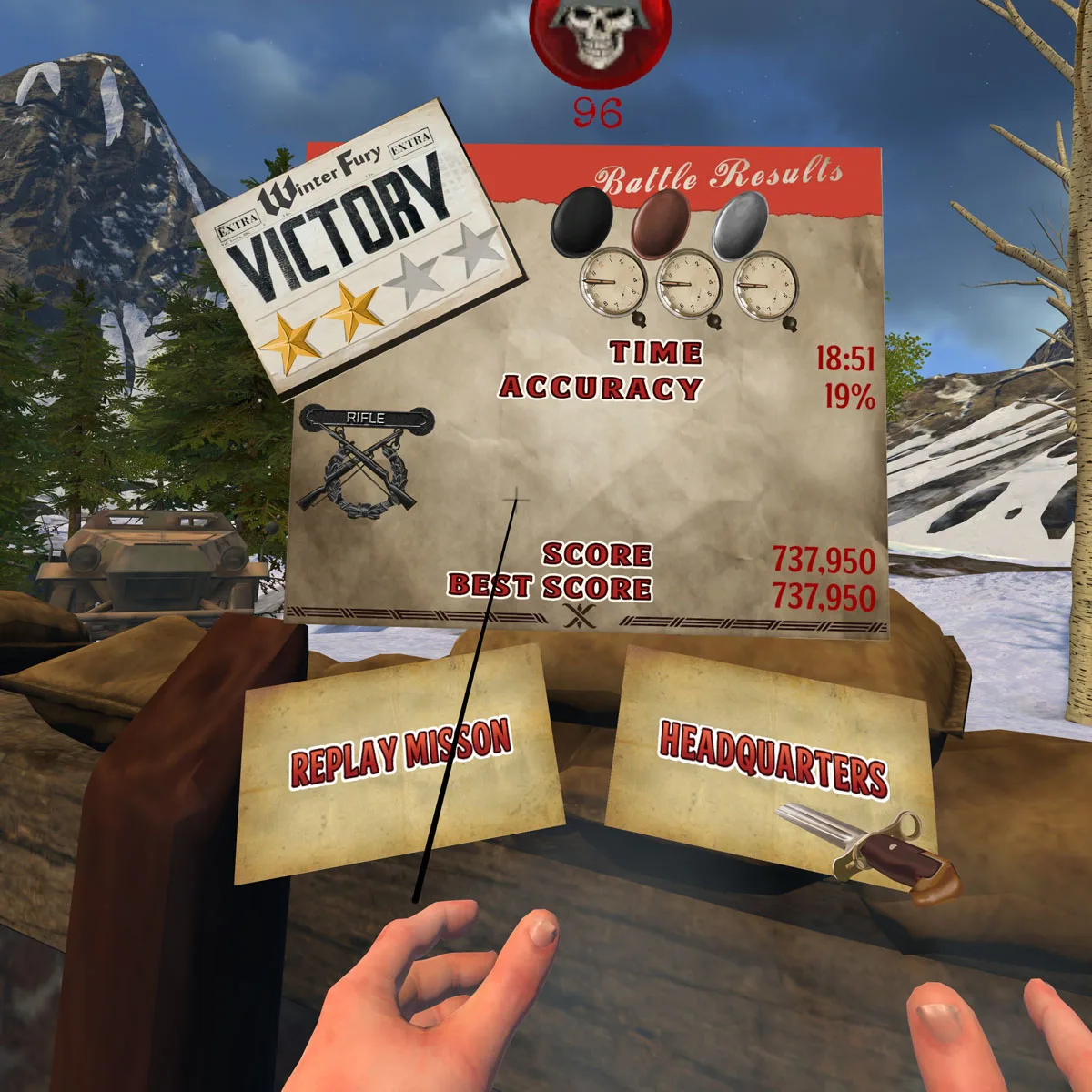
There were very few bugs we encountered although sometimes a gun in our hands would just vanish, enemy NPCs occasionally just appeared instead of spawning as usual, and once we could not capture a flag and had to restart the mission. Controls and reloading mechanisms are generally smooth and logical. It is a decent and varied VR experience with an emphasis on shooting Nazis and having fun.
Audio including Weapons sounds, Voice Acting & Replayability
The voice acting is poor but not so bad as to be campy which is what might have worked to give it more personality. It takes itself a bit too seriously even though there are “watch your step”, “that’s gonna hurt, or “line em up one at a time” comments repeated far too often. The frequent voice prompts to “watch out on your right” are meaningless and then become irritating as a new threat may just as well be coming from the left or from behind the player. The Germans also say the same thing over and over again. The battle music is nothing special and very repetitive although it is adequate.
The weapons sounds are not realistic but are also good enough, yet facing off against wave upon wave of multiple Axis weapons and soldiers never gets tiring and the scenario changes enough visually to give it just enough variety from one battle scene to the next. Splitting the campaign into two very different halves is a good idea for those who may be prone to VR sickness.
The game is fun if taken as a pure mindless shooting exercise with the Nazis as target practice. How long the game will take depends on how quickly a player gets used to the multiple weapon options and reloading, tossing grenades, and changing from fixed weapons to handheld automatics or becoming a good tank operator. We guess it will take from 3 to 6 hours, and perhaps it will gain replayability if the devs add an additional level of difficulty and some additional options they have talked about while the game was in Early Access.
The Graphics
The Winter Fury: The Longest Road graphics is ordinary but it is made to run on entry-level graphics cards like the GTX 1060 and the RX 290. Since we used a RTX 2070 Super, we increased the resolution to 1.7X with 4xAA for the Vive Pro and to 2.0X with 8xAA using the Rift CV-1. 
Using our high AA and increased resolution multiplyer, our RTX 2070 Super delivered 125.2 unconstrained FPS to the Rift CV-1 with no dropped frames while it delivered 137.5 FPS to the Vive Pro with 24 dropped frames over 110 seconds. We could not set 8xAA from 4xAA at 1.7x resolution without going into reprojection with the Pro causing a bit of VR distress, although we might have managed a further resolution bump for both HMDs.
The Verdict: Overall Winter Fury: Longest Road is fun and challenging
Winter Fury: The Longest Road is not a AAA game with a huge studio behind it. It’s a relatively short $14.99 indie World War II Nazi fighting wave shooter with two very different campaigns that each emphasize fun. The first one puts you in command of an experimental tank with multiple ways to take down a variety of enemies that spawn in progressively stronger waves. It’s not a sim, but more like an arcade shooting experience that depends on successfully coordinating multiple activities simultaneously. The second campaign is less dependent on a tank and it requires that a player move and duck.
Winter Fury: Longest Road is a fun game that isn’t just a tank sim, but a wave shooter with addictive gameplay. Several times, we just intended to get a screenshot but ended up playing and completing a mission or two.
If we have to give Winter Fury: Longest Road a score, we will give it 6.8/10. Despite its flaws, it is a fun tank-based World War II Nazi wave shooter. What you see in the first hour is what you get, and prospective players may want to take advantage of Steam’s satisfaction guarantee to make sure that it is $14.99 well spent for them. We like it and we would love to hear what our readers think in the Disqus comments below.
Next, we’ll follow up by examining AMD’s claim that the RX 5500 XT is “VR Premium Ready” using the Vive Pro by comparing it with the GTX 1660 and the RX 590.
Happy Gaming!
